Owls Head amateur solar astronomer offers tips for safely observing April 8 Solar Eclipse
A total solar eclipse will shadow the sun on Monday, April 8, around 3:30 p.m. For those fortunate enough to view totality, darkness will descend and the sun’s reddish corona will be observed. Stars will be visible. It’s a view that you will never forget. For others who are outside the path of totality, such as the coastal area, the experience will still be memorable. The sky will be dark enough so that Venus and Jupiter will be visible. Birds will become quiet and the temperature will drop.
The center of the path of totality will stretch along a line from Jackman to Houlton. The path is about 125 miles in width. Here in the Midcoast we won’t see a total eclipse but most of the sun will be covered by the moon. In Rockland, the coverage will be about 97%. Where visible, the period of totality is relatively brief - about 4 minutes along the center line and about a minute toward the edge. The overall duration will be somewhat in excess of 2 hours.
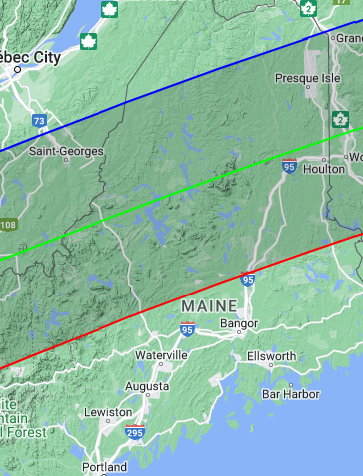
Mainers will pause in their activities to view this amazing natural phenomenon. Yet, nature needs to be viewed safely. Viewing any portion of the sun through uncertified means, even through an unprotected camera or phone lens, can lead to permanent eye damage. And, manufacturers are telling customers to order before mid March in order to receive their packages in time.
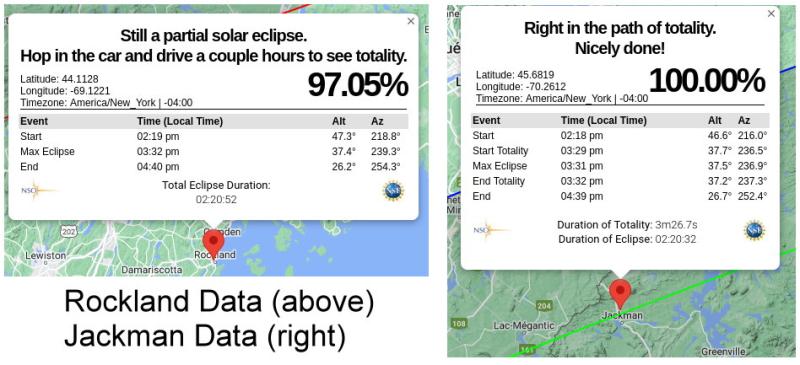
A solar eclipse happens when the moon comes between the sun and the earth. If the moon doesn’t fully align with the sun we will have a partial eclipse. If the apparent diameter of the moon is smaller than that of the sun, we will experience an annular eclipse. This was the case with the eclipse of last October. If the moon fully covers the sun, we will have a total eclipse.
A total solar eclipse consists of 3 components. There are the partial phases before and after the maximum where the moon partially obscures the sun. All of Maine will see this. Then, for those in a certain band that will stretch across the state, the initial partial phase will give way to a complete covering of the sun by the moon. This is totality. After a few minutes, this gives way to the second partial phase.
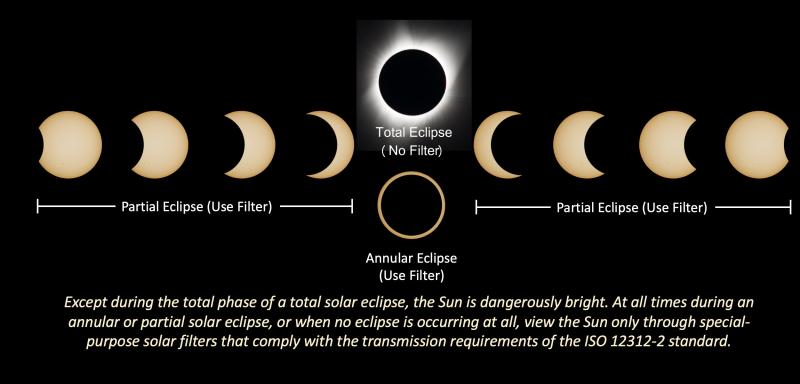
The National Solar Observatory (NSO) has a very useful online interactive map. This shows the path of totality from Mexico through New Brunswick and Newfoundland: https://nso.edu/for-public/eclipse-map-2024/
If you click on any point on the map you will get information on the eclipse at that location.
The safety aspect cannot be overstated. You can be quickly and permanently blinded by taking shortcuts. Things like certified eclipse glasses are widely available and only cost a couple of dollars. Inexpensive filters are also available for binoculars, telescopes and even for your smartphone’s camera (like your eye, your camera will likewise be damaged by direct sunlight).
We are nearing the peak of solar cycle 25. The sun is very active in this cycle with the result that sunspots are readily visible on just about any clear day with the proper equipment, for example with filtered binoculars or spotting telescope. Activity is expected to be high through 2026.
Location and Weather
First you will need a good viewing location. The time of maximum eclipse in Maine is about 3:30 PM. At this time the sun will be about 38 degrees above the horizon at a bearing of about 240 degrees, basically west southwest. A large cleared field or a cleared hilltop are best. Scout out locations first and be aware that desirable and easily accessible locations may well be crowded. Above all, respect private property and drive carefully.
The weather is the big unpredictable element. Historically, early April is not known for clear skies. The really serious eclipse watchers will be traveling to places with a high probability of clear skies. For this eclipse, this means Mexico and Texas will be hot spots. Based on history, cloud coverage in Maine on April 8 is expected to be around 80%. Hopefully we’ll have nothing worse than patchy clouds that will permit most of the eclipse to be visible. Even with an overcast, you will observe a dramatic darkening of the sky.
Viewing the Sun During the Partial Phases
Whether you plan to venture into the path of totality or just witness the partial but significant obscuring of the sun, you need to protect your eyes with effective filtration during the ENTIRE duration of the partial phases. You can look at the sun during totality without any eye protection. For viewing the partial phases you will need to use an approved solar filter. For eye safety, be sure to stop looking at the unfiltered sun no later than when the sun’s disk just starts to reappear. Sunglasses won’t keep you safe. Nor will overexposed color film, DVDs, smoked glass, etc. This section will discuss a number of safe and inexpensive options for directly observing the sun. Not only must the filter block most (99.999+%) of the sun’s visible light, it also must block the harmful ultraviolet (UV) and infrared (IR) radiation.
Fortunately, safe filters are readily available at very low prices.
For one thing, you can get a #14 welders glass. This is a very traditional approach. These are rectangular, about 2 x 4½ inches. The number indicates the density of the filter - higher is less transmission. Don’t go below #14! Most local welding shops don’t have this density but you can get them online for around $5.
A better, more convenient and somewhat less expensive, option is to get certified solar glasses. There are many options for inexpensive solar glasses that are made especially for eclipse watching. These are readily available from retailers such as Amazon and come in packages of 1 up to 100 and more. They are made of stiff cardboard and have a special double coated filter made of optical quality plastic film. The cost for a pair of these glasses is typically under $2.00.
Only a very few companies make the solar film. Many more companies use one film or another (all certified) to make their filter products. For example, there are many glasses with custom logos and even humorous graphics, like dinosaur or unicorn themed glasses.
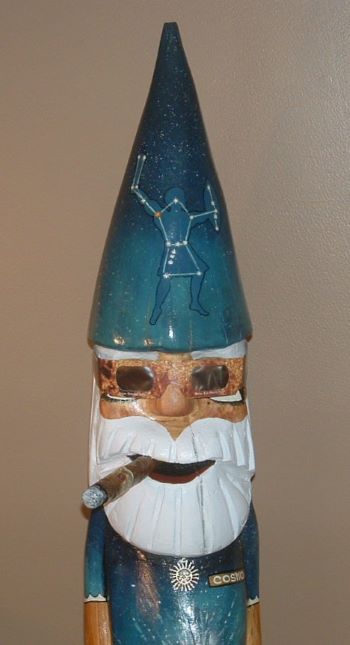
You will notice that these bear a notice indicating that the filter is compliant with ISO-12312-2 “Filters for Direct Observation of the Sun.” This will be noted in advertising and on the product. Don’t purchase anything that lacks this certification. For example, some products state that they are approved by NASA. NASA doesn’t certify products. Mentioning NASA just sounds good. The ISO approval must be present.
These filters can be damaged with improper handling or storage. Discard any filter with an obvious tear or other damage. A good test is to look at a high wattage light bulb through the filter. If you see any light coming through a pinhole or larger defect, discard the glasses. Don’t risk eye damage or blindness.
Be careful when you are wearing the glasses. You will essentially be blindfolded as you won’t be able to see anything but the sun. Take them off before you walk or move around.
Three things can be seen with eclipse glasses: arc welding, the sun and nuclear explosions.

Go Bigger
To the naked eye, the sun is not very large. With a bit of magnification you will see sunspots on the disk and the corona will be even more dramatic. Binoculars and spotting telescopes are owned by many individuals and you can add filters that fit over the objective (large) end of these for observing the partial phases. DO NOT try to look through any telescopic device using eclipse glasses or a filter on the eyepiece(s). The light of the sun can damage the internal optics of the telescope or binocular and also the concentrated heat at the eyepiece can damage eclipse glasses and other filters.
As one example, ICStars in Missouri has inexpensive filters that will fit 50 mm binoculars. These are sold in pairs for about $30. They also have single filters for camera lenses as well as larger telescopes. Like the eclipse glasses, these have cardboard frames. Once folded, they attach securely to the binoculars or telescope. Having a filter fall off or get blown off by the wind while looking through the instrument can cause instant blindness. Check the fit before use. https://www.icstars.com/Store/universal-lens-filter-50mm-aperture-bino.html
As another option, Celestron, a major manufacturer of high quality astronomical instruments, has a line of dedicated solar binoculars where the filters are built in. Cosmo has a pair of Celestron EclipSMART 10x42 solar binoculars that cost a relatively modest $70. These are very rugged and, if you get a bit hooked on observing the sun, you can use them on a regular basis for checking out sunspots. These may be obtained from astronomy supply companies or from Amazon.
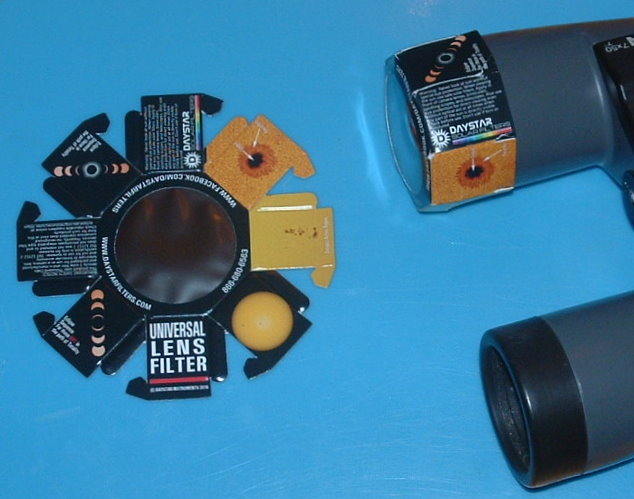
For those that get hooked, more durable filters with metal frames are available. These use the same types of filter as the cardboard versions. One supplier is Kendrick Astro in Toronto, Canada.
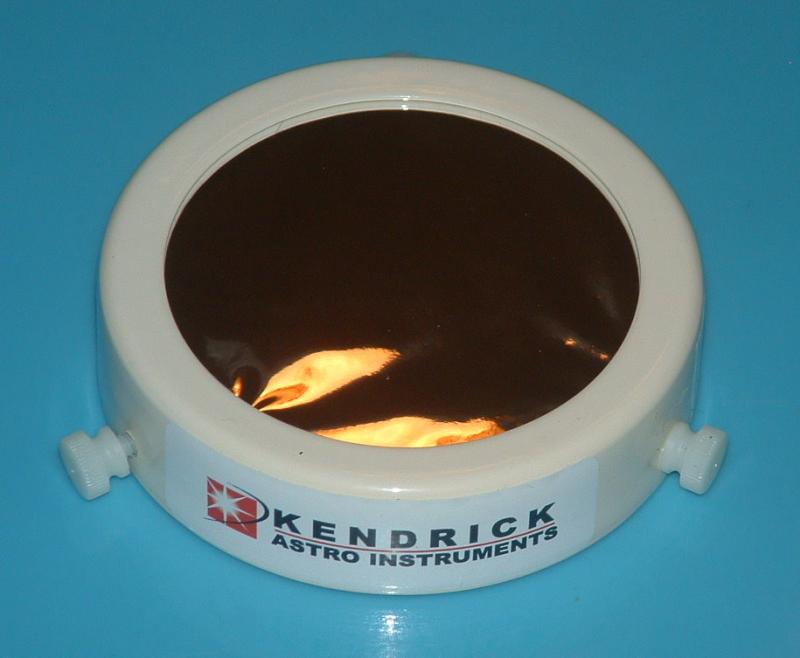
Metal frame filter with thumbscrews for secure attachment. The filter material is the same as the types used for the cardboard framed glasses and filters. If you decide you want to look at the sun on a regular basis, these are very durable. Many sizes and options are available. https://www.kendrickastro.com/solarfilters.html#VisualSolarFilterwithSolarFinder
The filter on Cosmo’s telescope at the top of this article is made by Baader Planetarium. This style is available from https://alpineastro.com/collections/baader-solar-filter
Photography with your Smartphone
American Paper Optics has a product called Solar Snap that consists of a package with 2 eclipse glasses, 2 filters for your smartphone and an app that works with your iPhone or Android. The product was the 2023 International Astronomical Union Astro-photography contest winner and was designed by former Hubble Space Telescope astronomer, Dr. Doug Duncan. The price is $14.99. It can be purchased directly from the manufacturer (link below) or Amazon.
https://www.eclipseglasses.com/collections/solar-snap-eclipse-app/products/solar-snap-the-eclipse-app
You can access the app instructions and hints at https://www.eclipseglasses.com/pages/solar-snap

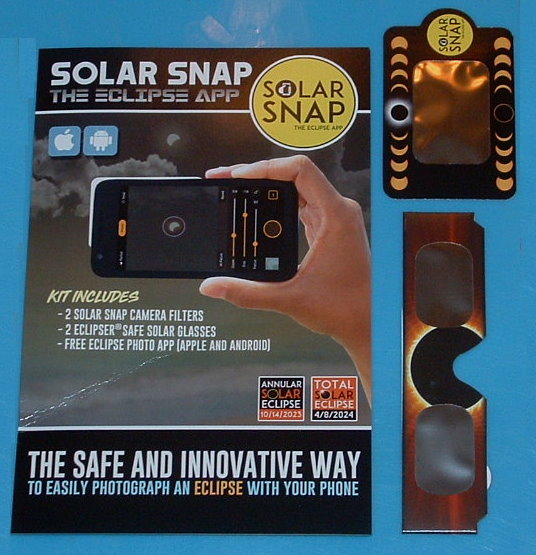
During totality, don’t get wrapped up in taking photographs. Enjoy the view of the sun’s corona!
Other Resources
Highly recommended for further information is “Your Guide to the 2024 Solar Eclipse” by veteran observer and senior editor of Astronomy Magazine, Michael E. Bakich. Available from Amazon.
https://www.amazon.com/dp/1627009132?psc=1&ref=ppx_yo2ov_dt_b_product_details
There is also a list of “Suppliers of Safe Solar Filters & Viewers” that has been assembled by the American Astronomical Society https://eclipse.aas.org/resources/solar-filters
Summary
Beyond the eclipse, the sky is the limit (pun intended) for visual observation and photography of the sun. This can range from casual observations to participation in formal programs to provide observational data to the professional community.































